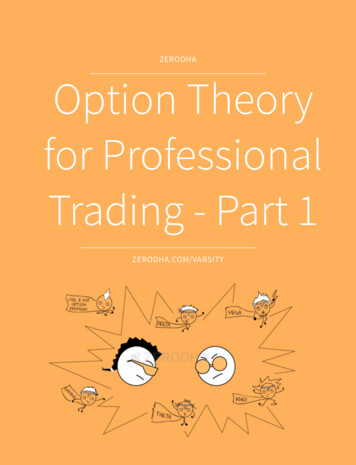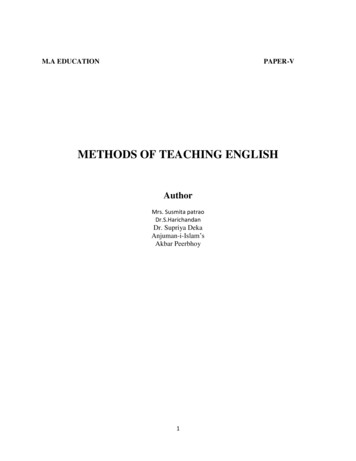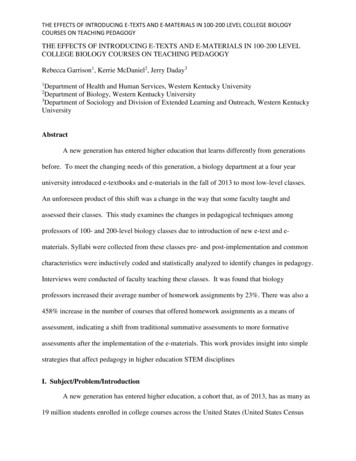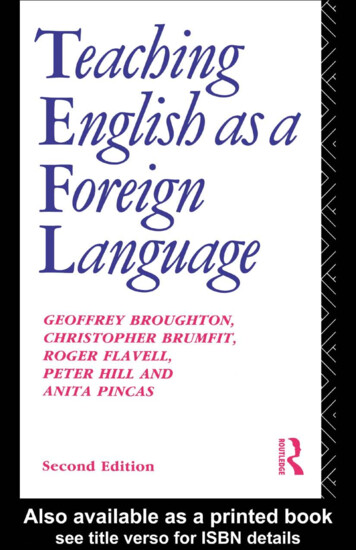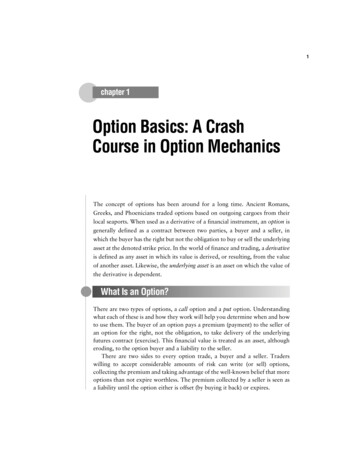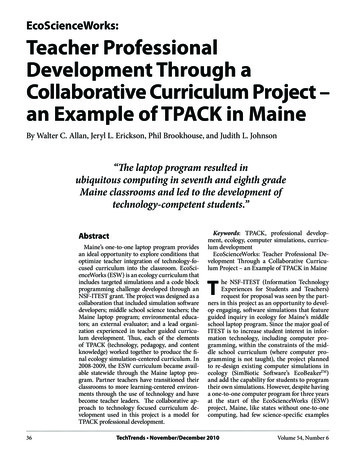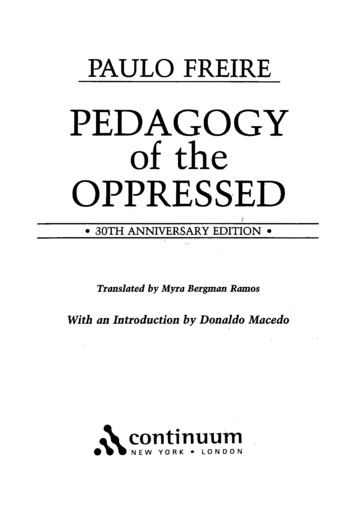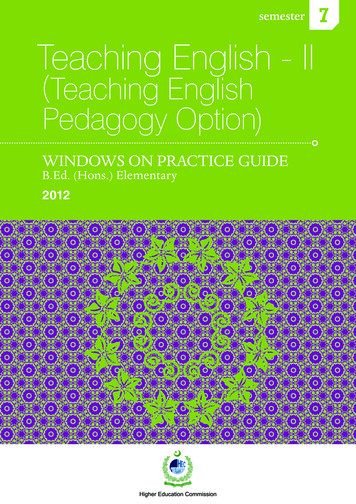
Transcription
semesterTeaching English - II(Teaching EnglishPedagogy Option)WINDOWS ON PRACTICE GUIDEB.Ed. (Hons.) Elementary20127
This product has been made possible by the support of the American People through the United States Agency forInternational Development (USAID). The contents of this report are the sole responsibility of the authors, and donot necessarily reflect the views of USAID or the United States Government.Technical Support: Education Development Center (EDC); Teachers College, Columbia University
ForewordTeacher education in Pakistan is leaping into the future. This updated Scheme of Studies is the latestmilestone in a journey that began in earnest in 2006 with the development of a National Curriculum,which was later augmented by the 2008 National Professional Standards for Teachers in Pakistan andthe 2010 Curriculum of Education Scheme of Studies. With these foundations in place, the HigherEducation Commission (HEC) and the USAID Teacher Education Project engaged faculty across thenation to develop detailed syllabi and course guides for the four-year B.Ed. (Hons) Elementary and thetwo-year Associate Degree in Education (ADE).The syllabi and course guides have been reviewed by the National Curriculum Review Committee(NCRC) and the syllabi are approved as the updated Scheme of Studies for the ADE and B.Ed. (Hons)Elementary programmes.As an educator, I am especially inspired by the creativity and engagement of this updated Scheme ofStudies. It offers the potential for a seismic change in how we educate our teachers and ultimately ourcountry’s youngsters. Colleges and universities that use programmes like these provide their studentswith the universally valuable tools of critical thinking, hands-on learning, and collaborative study.I am grateful to all who have contributed to this exciting process, in particular the faculty and stafffrom universities, colleges, and provincial institutions who gave freely of their time and expertise forthe purpose of preparing teachers with the knowledge, skills, and dispositions required for nurturingstudents in elementary grades. Their contributions to improving the quality of basic education inPakistan are incalculable. I would also like to thank the distinguished NCRC members, who helpedfurther enrich the curricula by their recommendations. The generous support received from theUnited States Agency for International Development (USAID) enabled HEC to draw on technicalassistance and subject matter expertise of the scholars at Education Development Center, Inc., andTeachers College, Columbia University. Together, this partnership has produced a vitally importantresource for Pakistan.PROF. DR SOHAIL NAQVIExecutive DirectorHigher Education CommissionIslamabadB.ED. (HONS) ELEMENTARYii
How this course guide was developedAs part of nationwide reforms to improve the quality of teacher education, theHigher Education Commission (HEC), with technical assistance from the USAIDTeacher Education Project, engaged faculty across the nation to develop detailedsyllabi for courses in the new four-year B.Ed. (Hons) Elementary programme.The process of designing the syllabus for each course in years 3 and 4 of theprogramme began with curriculum design workshops. Deans and directorsfrom universities where these courses will be taught were invited to attend theworkshops. The first workshop included national and international subject matterexperts who led participants in a seminar focused on a review and update ofsubject (content) knowledge. The remainder of this workshop was spent reviewingthe HEC Scheme of Studies, organizing course content across the semester,developing detailed unit descriptions, and preparing the course syllabi. Althoughthe course syllabi are designed primarily for Student Teachers taking the course,they are useful resources for teacher educators, also.Following the initial workshop, faculty participants developed teaching notesthat included ideas for teaching units of studies and related resources. Workingindividually or in groups, participants focused on their own teaching methodsand strategies and how they could be useful to the course’s future teachers.Subsequent workshops were held over the course of a year to give faculty sufficienttime to complete their work, engage in peer review, and receive critical feedbackfrom national and international consultants. In designing both the syllabi and theteaching notes, faculty and subject matter experts were guided by the NationalProfessional Standards for Teachers in Pakistan (2009).All of the syllabi developed by faculty who participated in the workshops areincluded in this document, along with a list of topical teaching notes. Additionalreferences and resources appear at the end of the document. These should providea rich resource for faculty who will teach this course in the future. Sample syllabiwith accompanying teaching notes are also included to provide new Instructorswith a model for developing curriculum and planning teaching and learning. ThisWindows on Practice guide is not intended to provide a complete curriculum witha standard syllabus and fully developed units of study; rather it aims to suggestideas and resources for Instructors to use in their own planning. Hence, readerswill find sample units and materials that reflect the perspective of faculty designersrather than prescriptions for practice.iiiHOW THIS COURSE GUIDE WAS DEVELOPED
We are respectful of intellectual property rights and have not included anysuggested materials that are copyright protected or for which we have notsecured explicit permission to use. Therefore, all materials included may beused in classrooms for educational purposes. Materials in this document arenot intended for commercial use, however. They may not be used in otherpublications without securing permission for their use.Initial drafts were reviewed by the National Curriculum Review Committee(NCRC) and suggestions were incorporated into final drafts, which were thensubmitted to the NCRC for approval.Faculty involved in course design: Shehla Sheikh, Gomal University; D. I. Khan,Munazza Tariq University of Education, Lahore; Dr Syed Shafqat Ali Shah,University of Gujrat; Shahbano Bukhari, University of Education, Lahore; AbdulSaeed, Karakoram International University, Gilgit; Maria Bint Shahid, FatimaJinnah Women University, Rawalpindi; Abdul Shakoor, University of Hazarah,Mansehra; Dr Muhammad Alam, University of Sargodha; Maaha Yousuf Bari,University of Karachi; Abdul Sattar Gopang, University of Sindh, Jamshoro;Mamonah Ambreen, Allama Iqbal Open University, Islamabad; and BushraBatool, University of Balochistan, Quetta.National subject expert guiding course design: Dr Hina Ashraf, AssistantProfessor, Air University, Islamabad.Date of NCRC review process: 24–25 April 2013.NCRC Reviewers: Dr Mussarat Anwar Sheikh, Fatima Jinnah Women University,Rawalpindi; Dr Ishtiaq, Kohat University; and Dr Qaisera Sheikh, School ofEducation, Beacon House National University, Lahore.B.ED. (HONS) ELEMENTARYiv
Table of contents1Rationale for the course Teaching English II.72Common misconceptions about teaching English.8Course syllabi.10Syllabus 1.11Syllabus 2.17Syllabus 3.223Integrated teaching notes.26Notes for Example 1: Introduction to Teaching English II.27Notes for Example 2: Integrating literature into theteaching of language.33Notes for Example 3: Teaching grammar and vocabulary.45Notes for Example 4: Benchmarks and standards in ELT.52Notes for Example 5: Action research in ELT.76Notes for Example 6: Assessment in ELT.844Annotated references.915Methods and strategies to use in teachingand learning .100
1Rationale for thecourse TeachingEnglish II
The course Teaching English II in the B.Ed. (Hons) four-year degree programmebuilds on an earlier course, English II (Semester 4), which introduced StudentTeachers to the nuances of second-language teaching; the approaches, theories,and methods of the teaching of English; and developing the four language skills(listening, reading, speaking, and writing).The teaching and learning of English have been a critical issue in the Pakistanieducation system, particularly with the widening gaps between English-mediumand Urdu-medium streams, as well as government and private sector schools. Aftertaking this course, Student Teachers would be more cognizant of the drawbacksin English Language Teaching (ELT) programmes and more positive aboutaddressing them through their own teaching exposure. The current course aimsto involve Student Teachers in real-life ELT situations in Pakistan by giving themthe opportunities of practical experience. With an orientation to the latest research,the course would also help them understand the significance of research in the fieldof the teaching of English, particularly in Pakistan. This shall be done throughmicroteaching sessions and action research projects that would provide themopportunities to apply the knowledge gained in the earlier semesters.Common misconceptions aboutteaching EnglishIn this section, we examine possible myths about the Teaching English IIcurriculum. These misconceptions are rather general, but they need to bedeconstructed for Instructors and Student Teachers.Myth: Generally, a course in teaching English is considered a course for helping toadvance English language proficiency.Fact: This course does not centre on imparting language skills and proficiencyto Student Teachers. It aims to develop their pedagogical ability to teachEnglish courses in elementary grades. The Student Teachers are expected tohave gained knowledge of the English language by this time.Myth: This course is similar to and/or a repetition of the Teaching English coursetaught in Semester 4.Fact: This second pedagogy course builds on the earlier one. The earlier coursefocused on the approaches to teaching English and their link with differentmethods of English language teaching. The current course offers insightsinto the intricacies of teaching English through contextualized experiences,microteaching sessions, and more significantly by exposing teachers toresearch in the field.B.ED. (HONS) ELEMENTARY08
Myth: This course is centred on Western theories of learning and does notrelate to countries where English is a second language and taught as asecond-language.Fact: This course is prepared to address the issues and problems of secondlanguage pedagogy in Pakistan. Focusing on the background of Pakistan’smultilingual and plurilingual settings, this course draws Student Teachers’attention to the problems of learning English specific to Pakistani learnersand in particular students enrolled in grades 6 to 8. It also draws StudentTeachers’ attention to the latest research in the field of teaching English inPakistan as well as possible solutions through action research and miniresearch projects and their reports.09COURSE GUIDE: Teaching English II (Teaching English Pedagogy Option)
2Course syllabiTEACHING ENGLISH IIB.ED. (HONS) ELEMENTARY10
The following section presents three different syllabi prepared for this course.Instructors and institutes should select any one of the three syllabi. They are alsoencouraged to adopt from the given syllabi to meet the needs of their students andinstitutes.SYLLABUS 1ByAbdul Saeed (Karokoram International University, Gilgit), Maria BintShahid (FJWU), Muhammad Alam (University of Gujrat), and Mr AbdulShakoor (University of Hazara).Year and semesterYear: 4, Semester: 7Credit valueCredit value: 3 creditsPrerequisitesEnglish II (Semester 4)Course descriptionThis three-credit hour course has been designed to develop pedagogical skills inStudent Teachers for teaching and assessing the English language to students inelementary grades. The course spans 16 weeks. The basic aim of the course is toenable Student Teachers to master the pedagogies related to teaching and assessmentin the English language. Student Teachers will also be able to integrate the practicalactivities meant for the development of the four skills with the pedagogies. Theywill also gain practical experience in the teaching of grammatical as well as lexicalaspects of the English language. Student-centred and communicative approaches willbe followed. The course will include a research-based project related to teachinglearning problems in English as a Second Language (ESL) classrooms and theirpotential solutions. At the end of the course, Student Teachers will have a goodunderstanding of practical classroom problems in the teaching of English and theirsolutions. This course aims to enable Student Teachers to put their knowledge ofdifferent English language teaching approaches learned in the previous course intopractice most suitably according to their own specific needs.11COURSE GUIDE: Teaching English II (Teaching English Pedagogy Option)
Course outcomesAt the end of the course, Student Teachers are expected to: be able to adapt and implement pedagogical skills in ESL classes be able to select, organize, and use resources and materials in order to developtheir students’ language skills have a conceptual knowledge and effective application of various theories andtools of assessment in ESL classrooms apply theories related to the teaching of grammar and vocabulary withcontextualized and communicative methods identify potential problems faced in actual ESL classroom situations throughresearch projects.Learning and teaching approachesThe communicative approach will be used to ensure maximum participationof learners through interaction and activities. The learners will also be involvedin research projects in ESL contexts to identify the prevalent problems in actualteaching-learning practices and to seek possible solutions.B.ED. (HONS) ELEMENTARY12
Semester outlineUnit 1: Pedagogy of four basic skillsThis unit will cover first the 5 weeks and 12 sessions of the course. At the completionof the unit, Student Teachers will be able to explain and use at an advanced levelthe concepts of different approaches to ESL teaching-learning and integrate theseapproaches into their classrooms. Moreover, Student Teachers will also be able toadapt the best-suited approach to teaching English as a second language to theirspecific needs.1UNIT 1:Week1Pedagogy of four basic skillsTopicIntroduction and orientation by the InstructorReview of the Semester 4 syllabus outline2Review of the approaches and methods of second-language teaching; i.e.grammar-translation, audio-lingual, direct method, communicative, and naturalapproaches3Devising lessons for the development of reading and writing skills with the useof the grammar-translation approach4Application of the communicative approach in the classrooms incorporating thefour language skills: listening, speaking, reading, and writing5Application of the natural and interactive approaches in the classroom forincorporating the four language skillsUnit 2: Integrating literature into the teaching of languageThis unit will span three weeks in six sessions. At the end of the unit, StudentTeachers will be able to incorporate poems and short plays into the teaching ofEnglish. The unit focuses on the scope of literature in the teaching of English atvarious levels, particularly in elementary grade classes.2UNIT 2:Week13Integrating literature into the teaching of languageTopic6Need for and scope of integrating literature into language teaching7Using poetry and short stories for the teaching of grammar8Using short stories and role plays in the teaching of EnglishCOURSE GUIDE: Teaching English II (Teaching English Pedagogy Option)
Unit 3: Teaching grammar and vocabularyThis unit is based on two weeks and six sessions. At the completion of the unit,Student Teachers will be able to apply theories, methods, and techniques of grammarand vocabulary teaching at an advanced level using a communicative languageteaching approach in the ESL context.3UNIT 3:WeekTeaching grammar and vocabularyTopic9Teaching of vocabulary and related approaches and theories10Teaching of grammar and related approaches and theoriesUnit 4: Approaches to language assessmentThis unit spans three weeks and nine sessions. It focuses on imparting theoreticalknowledge about language testing and devising assessment strategies at elementarygrade levels. At the completion of the unit, Student Teachers will have learned aboutlanguage testing and will be prepare to efficiently assess language skills throughdifferent tools in English language classrooms.4UNIT 4:WeekApproaches to language assessmentTopic11Discrete and integrative approaches to language testing12Essay-translation approach versus the structuralist approach13Integrative and communicative approaches in language testingUnit 5: Identification of ELT problems in ESL classesThis unit spans three weeks and nine sessions. By the end of this unit, StudentTeachers will be able to identify and explore solutions to potential problems faced inactual ESL classroom practices.5UNIT 5:WeekIdentification of ELT problems in ESL classesTopic14Orientation to research tools15Fieldwork16Reflection based on fieldworkB.ED. (HONS) ELEMENTARY14
Textbooks and referencesThe course will draw on textbooks, journal articles, and websites. A list of these willbe distributed in class.Course assignmentsStudent Teachers will be asked to go to the library in groups and consult Internetresources to select any two books or research articles on the communicativeapproach of teaching English and compare the ideas given in the books or researcharticles.Student Teachers will be asked to download at least five articles that explore the bestmethods to teach language skills. They will write down the main ideas presented intheir own words in five pages. They will select their favourite ways to teach theselanguage skills and write down the reasons why they have selected them.Grading policySuggested allocation of marks:AssignmentsClass participation/discussionsQuizMidtermFinal termPresentations and project write-upTotal10%5%10%20%35%20%100%Resources for Syllabus 1The following resources may be helpful in choosing appropriate readings. Thechoice of readings may be included on the syllabus or distributed in class, but theyshould include only resources that Instructors expect Student Teachers to usethroughout the course. Other readings should be distributed as needed.Atkins, R. (2002). Teaching tenses: Ideas for presenting and practising tenses in English.Brighton, East Sussex: ELB Publishing.Dass, L. (1989). A case for using newspapers in the teaching and learning of English as asecond language. Retrieved from:ØØ http://www.melta.org.my/ET/1989/main3.htmlKhatib, M., & Nasrollahi, A. (2012). Enhancing reading comprehension throughshort stories in Iranian EFL learners. Theory and Practice in Language Studies 2(2),240–246. Retrieved from:ØØ pdf15COURSE GUIDE: Teaching English II (Teaching English Pedagogy Option)
Kolln, M., & Hancock, C. (2005). The theory of English grammar in United Statesschools. English Teaching: Practice and Critique, 4(3), 11–31. Retrieved from:ØØ /2005v4n3art1.pdfLawson, M. J., & Hogben, D. (1996). The vocabulary‐learning strategies of foreign‐language students. Language Learning, 46(1), 101–135. Retrieved from:ØØ arning Strategies of Foreign-Language Students.pdfLittlewood, W. (1981). Communicative language teaching. London: CambridgeUniversity Press.Luoma, S. (2004). Assessing speaking. London: Cambridge University Press.O’Sullivan, R. (1991). Literature in the language classroom. The English Teacher, 20(2),53–60.Richards, J. C., & Theodore, S. R. (2005). Approaches and methods in language teaching.London: Cambridge University Press.Saricoban, A., & Metin, E. (2000). Songs, verse, and games for teaching grammar.The Internet TESL Journal, 6(10). Retrieved from:ØØ hamim, F. (2011). English as the language for development in Pakistan: Issues,challenges and possible solutions. In H. Coleman (Ed.), Dreams and realities:Developing countries and the English language. London: British Council.Swan, M., & Smith, B. (2001). Learner English: A teacher’s guide to interferenceand other problems. (2nd ed.) Cambridge handbooks for language teachers. Cambridge:Cambridge University Press.B.ED. (HONS) ELEMENTARY16
SYLLABUS 2ByAbdul Sattar Gopang (University of Sindh), Bushra Batool (University ofBalochistan), Maaha Yousuf Bari (University of Karachi), and MamonahAmbreen (Allama Iqbal Open University).Year and semesterYear: 4, Semester: 7Credit value3 creditsPrerequisitesEnglish II (Semester 4)Course descriptionThis three-credit hour course has been designed to train Student Teachers inteaching English in elementary grades. This course consists of 48 sessions to becompleted in 16 weeks. These sessions will be learner-centred, and they will beassessed in both formative and summative ways. The course aims to equip StudentTeachers with multiple methodologies and research-oriented activities to facilitatelanguage teaching. Student Teachers will also be trained to maintain validity in boththeir teaching and testing practices. One of the major aims of the course is to makeStudent Teachers self-sufficient and independent learners. Student Teachers will beenabled to make effective use of the language as a medium of instruction. Finally,Student Teachers will be able to design and develop their own teaching materials andactivities to make their students proficient in the English language.Course outcomesAt the completion of the course of English pedagogy, Student Teachers will beable to: adapt teaching methodologies to make their students proficient users of theEnglish language develop reliable and valid teaching materials, testing items, andevaluation criteria use English efficiently as a medium of instruction in the classroom make use of different texts and resources to teach language address potential problems faced in ELT classrooms develop competence in ELT.17COURSE GUIDE: Teaching English II (Teaching English Pedagogy Option)
Learning and teaching approachesThe course will be taught through language-learning approaches such as thecommunicative and interactive approach. During classes, handouts of the relevantmaterial will be distributed among learners so that they may read and discuss thematerial with each other. Individual, pair, and group activities will be devised tomake the classes activity based.Semester outlineUnit 1: Introduction to English pedagogyThis unit will cover the initial three weeks of the course, during which theInstructor will explain to Student Teachers about the course, the context in whichthey will be teaching, and the areas and topics in which they can research theirpractice.1UNIT 1:Week1: English asa medium ofinstruction2: Challenges inELT in Pakistan3: Research inELTIntroduction to English pedagogyTopicIntroduction to the courseScope of English used as a medium of instruction in PakistanWays of using the English language effectively as a means of instructionTypes of challenges in ELT in PakistanPossible suggestions to address the challengesOpportunities for ELT in the context of PakistanAwareness about key research in the field of ELTPotential areas of research in ELT in the context of PakistanB.ED. (HONS) ELEMENTARY18
Unit 2: Lesson planningThis three-week unit allows Student Teachers to plan and execute lessons, integratelearning, and plan for various learning profiles by making effective use of thelanguage theories discussed earlier. Student Teachers will be encouraged to use theexperience of designing activities to teach the four language skills they learned in theEnglish II course. They may do this individually or in groups.2UNIT 2:Week4: Planninglessons tointegratelanguage skills5: Planninglessonsconsideringmultipleintelligences6: Planninglessons adaptingand/or merginglanguage teachingmethodologiesLesson planningTopicScope of integration of teaching language skills in one sessionPlan and execute at least one such lesson either as microteaching or as an activityfor practicumScope of considering multiple intelligences in planning lessons for ELTPlan and execute at least one such lesson either as microteaching or as an activityfor practicumScope of adapting or merging language teaching methodologyPlan and execute at least one such lesson either as microteaching or as an activityfor practicumUnit 3: Teaching language through literatureThis unit spans three weeks, during which Student Teachers will learn and practicehow texts from literature can be used to teach language and make learningentertaining and meaningful. They will also learn to use a single text for teachingmultiple language items.3UNIT 3:Week7: Use of varioustexts to teachlanguage8 and 9: Usinga single textfor multiplepurposes19Teaching language through literatureTopicIdentifying kinds of texts (such as short stories and poems) from literature to usein elementary grade classroomsIdentifying elements of grammar to be taught through selected literary itemsUsing texts to conduct an integrated lesson, combining at least two languageskillsUsing texts through activities to inculcate language sensitivity among learnersAssisting cognitive development of the English language in students using thesetextsCOURSE GUIDE: Teaching English II (Teaching English Pedagogy Option)
Unit 4: Teaching the grammar and vocabulary of EnglishThis unit covers three weeks, during which Student Teachers will be introducedto various techniques of teaching English grammar and vocabulary in elementarygrades. It aims to draw Student Teachers’ attention to the problems of teachinggrammar and vocabulary to second-language learners.4UNIT 4:Week10 and 11:Teachinggrammar toEnglish languagelearners12: Teachingvocabulary toEnglish languagelearnersTeaching language through literatureTopicIdentifying elements of grammar for different levelsExploring teaching of grammar through literatureProblems of teaching grammar in Pakistani ELT classesGrammar-translation approachUsing texts to teach vocabularyStrategies of incorporating vocabulary into language teachingUnit 5: Researching assessment of language skillsThis unit covers three weeks, during which Student Teachers will implement theirprevious knowledge about testing language skills. They will pilot test items and themarking criteria they developed in the Semester 4 English II course to check theireffectiveness. After the exercise, they will write a report based on their reflection,experience, and lessons learned during piloting.5UNIT 5:WeekResearching assessment of language skillsTopic13 and 14: Pilottest items toassess languageskillsStudent Teachers will pilot the test items they developed during the English IIcourse15:Evaluationof pilotingReflection and evaluation on lessons learned through pilotingB.ED. (HONS) ELEMENTARY20
Textbooks and referencesAtkins, R. (2002). Teaching tenses: Ideas for presenting and practising tenses in English.Brighton, East Sussex: ELB Publishing.Shamim, F. (2001). English as the language for development in Pakistan: Issues,challenges and possible solutions. In H. Coleman (Ed.), Dreams and realities:Developing countries and the English language. London: British Council.Swan, M., & Smith, B. (2001). Learner English: A teacher’s guide to interferenceand other problems (2nd ed.). Cambridge Handbooks for language teachers. Cambridge:Cambridge University Press.Tomić, D. F. (1996). Challenges and rewards in the mixed culture classroom. CollegeTeaching, 44, 69–73.Suggested articles‘Challenges and Rewards in the Mixed Culture Classroom’ØØ http://www.jstor.org/stable/27558769‘English Language Teaching in China: Trends and Challenges’ØØ http://www.jstor.org/stable/3587867Course assignmentsShort research-oriented assignments will be given in individual and group forms tohelp Student Teachers to become creative and research-oriented teachers.Grading policyA variety of assessments will be used in the course, including midterm and finalexaminations.Suggested allocation of marks:Assignments and presentations, etc. (individual and group)MidtermProjectFinal term21COURSE GUIDE: Teaching English II (Teaching English Pedagogy Option)20 marks20 marks10 marks50 marks
SYLLABUS 3ByShehla Sheikh (Gomal University), Munazza Tariq (University ofEducation), and Shahbano Bukhari (University of Education).Year and semesterYear: 4 , Semester: 7Credit value3 creditsPrerequisiteEnglish II (Semester 4)Course descriptionThis three-credit course will be designed to enable Student Teachers to teachEnglish. It will be taught over 16 weeks with 3 sessions per week, for a total of 48sessions. The main goal of the course is to produce competent English teachers whoare aware of the problems of ELT and have the ability to address them successfullywith the help of effective pedagogy. The course will be taught through theInteractive Communicative Approach (ICA) as well as mini-research projects basedon school visits. Comparative research studies can be assigned to assess and analyseELT (in publi
The course Teaching English II in the B.Ed. (Hons) four-year degree programme builds on an earlier course, English II (Semester 4), which introduced Student Teachers to the nuances of second-language teaching; the approaches, theories, and methods of the teaching of English;
